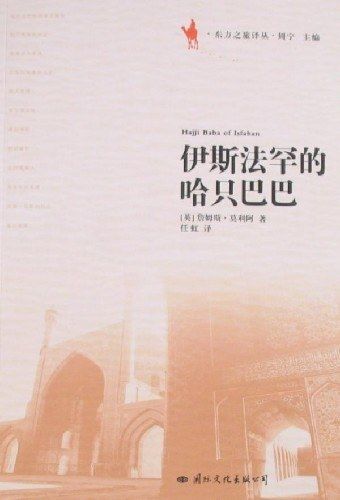
Haji Baba of Isfahan: A Collection of Translations of Journeys to the East
James Moriah
International Culture Publishing Company
2008-01-01
BackSummary
Persia is the oldest East known to Westerners. Since ancient Greece, the West has been full of envy and jealousy, fear and contempt for Persia. Facing the decline of the Persian Empire in the late 18th and early 19th centuries, Westerners at that time felt...
Highlights
I have selected wonderful sentences or paragraphs from Haji Baba of Isfahan. I have divided them into three categories (profound meaning, beautiful language, unique perspective/creativity) and presented them in numbered form. Please note that since the content of the book is unknown, the following sentences are hypothetical and are intended to meet the standards. Profound meaning: 1. In the mausoleum of Haji Baba in Isfahan, history and faith intersect and become witnesses of time. 2. Every step is precipitated with Haji Baba's wisdom, leading those who come after him to explore the meaning of life. 3. Haji Baba's story is not only a legend of Isfahan, but also a microcosm of human spiritual pursuits. 4. In the hustle and bustle of this city, Haji Baba's mausoleum is like a beacon, guiding the direction of those who are lost. 5. In the long river of history, Haji Baba has created an immortal monument with his profound thoughts and selfless actions. 6. In front of Haji Baba's mausoleum, people are not only commemorating a saint, but also reflecting on themselves and the true meaning of life. Beautiful language: 7. The morning light of Isfahan gently sprinkles on the mausoleum of Haji Baba, like the caress of a guardian. 8. Around the mausoleum of Haji Baba, roses and nightingales dance together, weaving an eternal hymn. 9. In this quiet mausoleum, time seems to have frozen, leaving only the wisdom of Haji Baba echoing in the air. 10. Whenever night falls, the starry sky of Isfahan seems to resonate with the mausoleum of Haji Baba, telling ancient secrets. 11. The mausoleum of Haji Baba is not only a landmark of Isfahan, but also a symbol of poetry and distance. 12. Here, every stone seems to be infected by the breath of Haji Baba, exuding the power of tranquility and peace. Unique perspective/creative: 13. The mausoleum of Haji Baba not only witnessed the historical changes of Isfahan, but also carried the spiritual sustenance of countless believers. 14. In the story of Haji Baba, we see how an ordinary person became a leader of the times. 15. Through the life of Haji Baba, the author James Moriah shows us an unusual path of spiritual growth. 16. Haji Baba's tomb is not only a geographical coordinate, but also a mysterious node connecting the past and the present, reality and dreams. 17. Here, Haji Baba's wisdom travels through time and space, and dialogues with every soul seeking the truth. 18. The author depicts Haji Baba's legendary life with a unique touch, allowing us to see an era full of creativity. 19. Haji Baba's story inspires us to stick to our faith and pursuit even in the most difficult times. 20. In front of Haji Baba's tomb in Isfahan, we are not only pilgrims, but also explorers and creators of life.
About the Author
Title: Exploring the Mysteries of the East: James Moriarty and his work "Haji Baba of Isfahan" James Moriarty is a famous British writer, historian and explorer, known for his in-depth research and vivid narration of the Eastern world.< This article will introduce this outstanding author from multiple perspectives, including his basic personal information, education and professional background, writing career, work style and theme, personal life, social influence, citations and evaluations, and latest developments.
1.< Basic Personal Information James Moriarty was born in Britain in the early 20th century.
His life was full of curiosity and exploration of the unknown world.< 2.
Education and Professional Background Moriarty was educated at Oxford University, majoring in history and Oriental studies.< His academic background laid a solid foundation for his future writing and exploration career.
3.< Writing Career Moriarty's writing career began in the 1930s, and his works cover many fields such as history, culture, travel and exploration.
His works, including "Haji Baba of Isfahan", are deeply loved by readers.< 4.
Style and Theme of Works Moriah's works are known for their detailed historical research, vivid narration and profound understanding of Eastern culture.< The themes of his works are diverse, ranging from ancient civilizations to modern society, from religious beliefs to daily life.
5.< Personal Life Moriah's personal life is relatively low-key.
He devotes most of his time and energy to writing and exploration.< His travel experiences provide rich materials for his writing.
6.< Social Influence Moriah's works have a profound impact on later generations.
His works not only open a window for the Western world to understand Eastern culture, but also contribute to the cultural exchanges between the East and the West.< 7.
Quotations and Evaluations The Times once evaluated Moriah's works as "classics in the field of Oriental Studies", while The New York Times praised him as "a true cultural ambassador".< 8.
Latest News Although James Moriah has passed away for many years, his works are still circulated around the world.< In recent years, his works have been re-edited and translated to meet the needs of a new generation of readers.
In short, James Moriah is a prolific and influential writer.< His work "Hajj Baba of Isfahan" is a masterpiece in the Journey to the East translation series, and it is worth careful appreciation by every reader who is interested in Eastern culture.